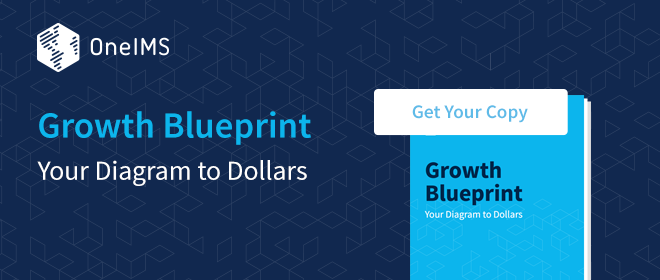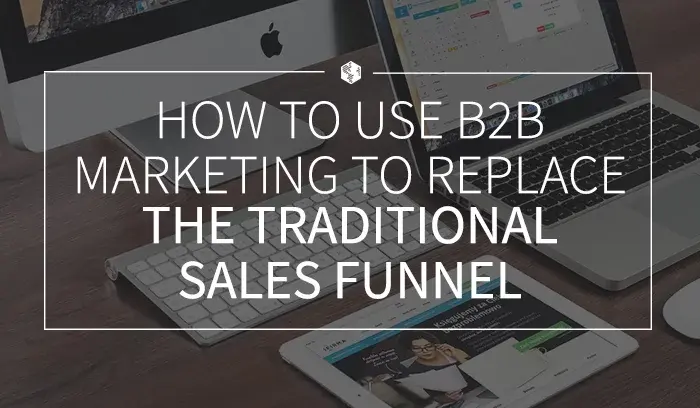Table Of Contents
Traditional selling used to mean collecting names and sending out a strong pitch. When customers weren’t able to research their options as easily as they can today, this was enough to convince them to buy. However, now that just about every company is putting content online, our customers know what their options are—completely killing the traditional sales funnel.
While a traditional sales pitch may not be enough to convert your customers, this doesn’t mean you have to struggle to sell your products or services. In order to reach your B2B buyers, you need to understand how this new information influences the way they buy, what information they need to make a decision, and how you can make up for the changed sales funnel.
In this article, we’ll first look at how the sales process has changed over time. We’ll then explain how a strong B2B marketing strategy can replace the traditional sales funnel in three simple steps. Let’s get started!

Key Takeaways:
- The ease of research has killed the traditional sales funnel, and buyers are now able to explore their options without ever talking to a salesperson.
- In order to accommodate for the loss of the sales funnel, B2B marketing must provide helpful content to attract potential customers.
- This can be achieved by finding out what research buyers are doing, then providing content that delivers what they need and encourages them to convert.
How the Traditional Sales Funnel Has Changed
In the past, selling a product or service first involved collecting contact information for people you thought might be interested in your product or service. Sales professionals would then reach out over the phone, through an email, or with another piece of marketing to try and garner attention. They’d explain the benefits of their products or services, convey how they could help solve the buyer’s problems, and give whatever information was needed to convince the buyer to make a purchase. In the traditional sales funnel, salespeople controlled the information. When a customer wanted more info, they’d have to contact a salesperson to get it.
However, today all that information is available online. With a quick entry into any search engine, buyers can find information about dozens of similar products, including detailed reviews on whether or not they lived up to customers’ expectations. Buyers no longer need a professional sales team to tell them what products or services they need. They’re able to do their own research, pushing them to contact sales professionals much later in the process. In fact, SiriusDecision reports that “67% of the buyer’s journey is now done digitally.”

How to Use B2B Marketing to Replace the Traditional Sales Funnel (In 3 Steps)
To appeal to potential customers in the new sales process, companies need to create marketing strategies that help expose them to their target audience and educate audience members. For B2B marketers, this can be done using a three-step process.
Step 1: Consider What Research Buyers are Doing on Their Own
According to SalesForce: “90% of business buyers say when they are ready to buy, they’ll find you.” This means they’re confident they can find the information they need to make a purchasing decision on their own. When the majority of the buyer’s journey is done digitally, you need to ensure you’re providing the right information to educate them and bring them closer to reaching out to make a purchase.

A price comparison chart, like this one from Desk.com, considers the high-level points that an audience member may want to know about when carrying out preliminary research. By seeing short snippets of information about each service tier, customers can better understand their own needs as well as how the company can help. This enables them to move through the buyer’s journey easily, without the assistance of a salesperson.
To provide the right kinds of content to your target audience, you first need to know what information they need. Consider what stages of the buyer’s journey the customer is in while doing independent online research. For example, the ‘awareness’ and ‘consideration’ phases are typically heavily influenced by autonomous research. Understand the specific details and insights needed to convince your audience member to move to the ‘decision’ phase of the buyer’s journey.
Step 2: Decide on Appropriate Content to Help Them
Once you know what kind of information your target audience is looking for, you need to find the best way to present that content. Different forms of content may be needed depending on your buyers, their unique needs and preferences, and where they are in the buyer’s journey. The product or service you’re selling will also influence the kinds of content you should be sharing.

Creating entertaining and educational videos, like the above Modern Mark example from Oracle Eloqua, is one way to offer content that appeals to both the awareness and consideration phases of the buyer’s journey. You can also use infographics, blog posts, case studies, and more, depending on the information you’re trying to share.
Your content needs to be delivered in a way that makes your audience stop and take notice. Even if you know they are looking for the information behind the content, presenting it in a boring or complex way can push them right into a competitor’s arms. In short, in order to grab and keep their attention, you need to display the right information in the right way.
Step 3: Create Killer Content That Leads Them to the Right Decision
Simply knowing what information to share and presenting it in an attention-grabbing way isn’t enough to convince your audience to purchase from you. If you want your B2B marketing to truly replace the traditional sales funnel, you also need to create extremely high-quality material that pushes them to convert.

This research post from Buffer is a great example of a valuable piece of top-quality content. Not only did the authors consider what information their audience would want to discover and the best way to present that information, they made sure to do the appropriate research to create an interesting read that brings value to visitors.
You can use your own research techniques to improve the quality of your material. Do in-depth keyword research, look into which kinds of content your audience enjoys, and see what your competitors are doing. You can also change things up occasionally to ensure you’re giving your target audience all the information they need while keeping things interesting. Moreover, make sure that every piece of content has a specific purpose and includes an appropriate call-to-action.

Conclusion
The loss of the traditional sales funnel can make it a bit more difficult to convince a customer to buy. However, when you create a B2B marketing strategy that provides your target audience with the right information to make a smart purchasing decision, your sales numbers don’t need to suffer.
Let’s recap the three steps that enable you to use B2B marketing to replace the traditional sales funnel:
- Understand what information your audience is looking for online.
- Use the appropriate content formats to educate them.
- Create valuable, informative, and persuasive content that convinces them to buy.
Do you have any tips for using B2B marketing to replace the traditional sales funnel? Let us know in the comments section below!
Image Source: Pexels.





